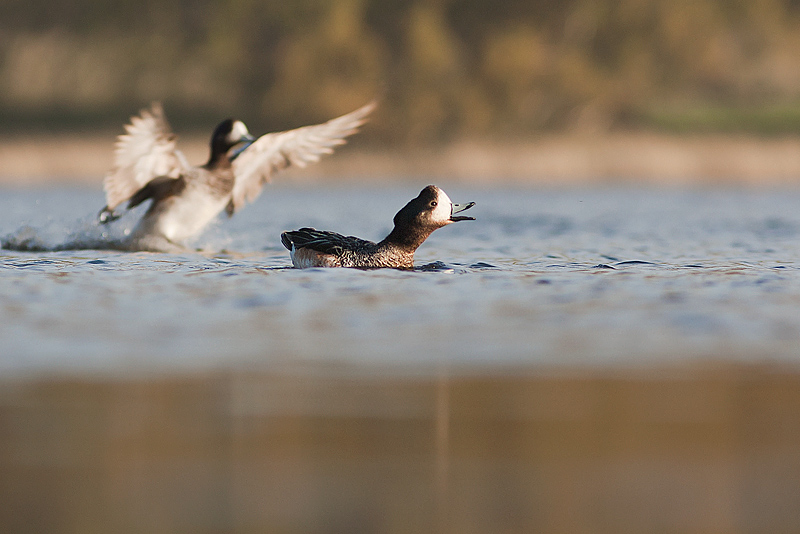Chiloe Wigeon
Pato Overo
Anas sibilatrix
Length: 500mm. Sexes slightly unlike. Male: bill light bluish grey with black nail; iris dark brown; forehead, lores and malar region white; auriculars white with blackish mottling; remainder of head black except in the posterior part of the sides of head and neck, which is black with striking blue and green metallic sheen; rest of neck blackish brown; anterior part of breast with alternating whitish and blackish bars; rest of breast and abdomen white; flanks rusty chestnut; under tail coverts white with rusty chestnut spotting. Upper back blackish with white-edged feathers; scapulars and tertiaries, likewise; lower back blackish brown; rump and uppertail coverts white; tail blackish. Lesser and median inner wing coverts blackish; outer median wing coverts and greater coverts white; secondaries velvet black, speculum likewise; primaries blackish brown with paler inner vexillum. Legs dark grey. Female: bill and iris as male; posterior part of sides of head and neck blackish with a faint bluish sheen; rest of body plumage as in male but duller; lesser and inner median wing coverts greyish brown; secondaries likewise.
Legs similar to male but smaller in size. Young plumage resembles adults but paler and browner overall. Habitat and behaviour: very common and easily identified, found in pairs or groups that number up to 30 or more individuals; quite boisterous, in feeding or roosting grounds the whistling of males and nasal vocalisations of females can be heard, creating a cheerful and festive environment. In order to fly, it springs up; its flight is quick with vigorous wing beats, and while airborne, it emits its characteristic calls and whistling. It generally inhabits ponds, rivers, streams and lakes; also found in shallow pools, grassy marshes and sea shores. It feeds on vegetation; walks long distances from water to feed on grass.
The Chiloe Wigeon nests on the ground, hidden in vegetation, close or a long way from water; nests are built in a hollow on the ground, lined with grass and covered with abundant down; clutch size: 6-10 cream white eggs. Range: from Río Negro and Neuquén to Tierra del Fuego and Islas Malvinas. Also found in Entre Ríos, Santa Fe, Buenos Aires, Córdoba; La Pampa and Mendoza; in winter part of the population migrates to southern Brazil, Paraguay and Uruguay. In Chile it is found from Atacama to the Chilean Tierra del Fuego.
Illustrated Handbook of the Birds of Patagonia
Kindless: Kovacs Family
|









